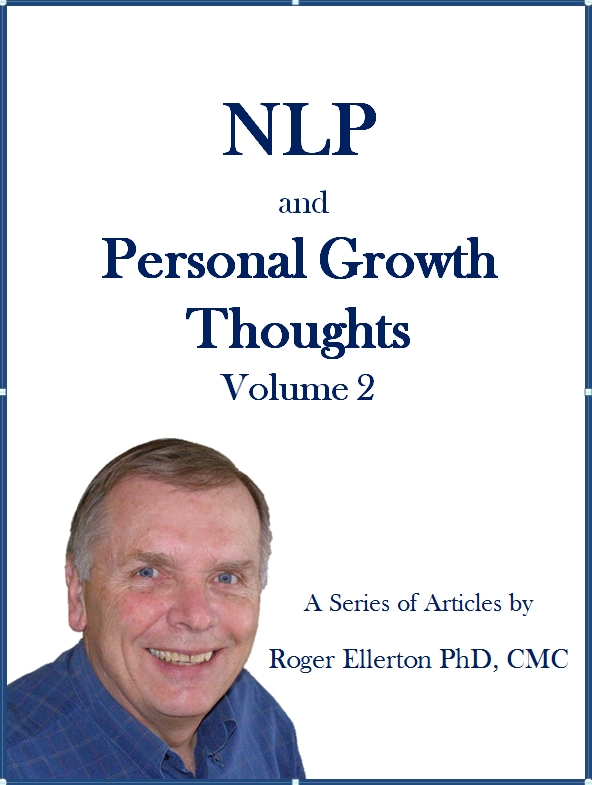Basic NLP Anchoring Concepts
By Roger Ellerton Phd, ISP, CMC, Renewal Technologies Inc.
This article may not be republished without written permission from Roger Ellerton/Renewal Technologies Inc. If you republish this article without permission, you will be in violation of copyright law and sent an invoice. You may share this and other pages with your friends by linking directly to this page from your website or blog.
For an introduction to anchors, please see NLP Anchors.
You can create anchors to serve you or change those that do not generate the results you want. To do this, you need to understand some basic concepts about anchors.
Anchors can be created naturally or artificially in two ways:
- In a single instance, if there is a highly emotional (positive or negative) event. E.g. your significant other takes you to a special place and proposes to you in a very romantic and emotional way. When you return to this location, what comes to mind?
- Repetition, the continual association between a stimulus and a response. Repetition is needed if the emotion is not strong or there is no emotional involvement. Television commercials often link an alcoholic beverage with a pleasant experience. After seeing this advertisement a number of times, you begin to make the association.
The anchor needs to be:
- Unique, distinct and easy to repeat. If touching your thumb and index finger is not something you do on a regular basis, then this would be a good kinesthetic anchor. Saying a word internally to yourself in a particular tone of voice would be a good auditory/auditory digital anchor. Selecting a trigger that you inadvertently fire quite often has the potential of dissipating the anchor and rendering it useless. Unique triggers make better and longer lasting anchors.
- Linked to a state that is cleanly and completely re-experienced. If your client wishes to create an anchor to feel confident in certain situations and he recalls a past event when he felt confident, but he was also confused as to your instructions, then the stimulus will generate a response that is a mixture of confidence and confusion.
- Timed just as the state is reaching its peak. As your client recalls a time that he had a certain attribute (e.g. confidence), the feeling of confidence will begin to get stronger until it reaches a peak. Generally, the anchor should be applied when the response is about 2/3 of its peak and held until it peaks. Depending on how fast your client accesses his feelings, the anchor could be applied anywhere from a couple of seconds to 10 seconds. Applying the anchor past the peak, may pick up a weakened state or some other state.
The basic steps for anchoring are:
- Have your client recall a past vivid experience for the state you are anchoring.
- Apply a specific trigger as the state is reaching its peak.
- Break state.
- Test the anchor. When you fire the trigger, does your client think of the state?
- Repeating steps 1 - 3 several times will make the anchor stronger. This is called stacking an anchor.
The best state to anchor is a naturally occurring state (e.g. you are laughing at a joke you just heard). The next best state is a past vivid highly associated state. If you wish to create an anchor for a specific state that you have never experienced, do you know someone that has that quality? Imagine stepping into that other person's shoes and taking on her physiology and feelings (this person can be real or imaginary).
To elicit a past memory for anchoring purposes, you can use the following scrip for yourself or with your client:
Remember a specific time when you were really _____ (e.g. confident). Close your eyes and fully associate into that memory by going back to that time, putting yourself in your own body, looking through your own eyes, seeing what you saw, hearing what you heard and have the feelings of being really _____.
You can also assist your client by using a voice tonality that reflects the state he is accessing. If he is accessing an energetic state, then your voice tonality would reflect energy.
To maintain an anchor, it should only be fired when necessary and have regular reinforcement. To reinforce (or build up) an anchor, you can either on a regular basis repeat the process you used to establish the anchor or if you notice you are naturally experiencing the state that you desire then fire the trigger to enhance the anchor.
To make an anchor really strong or to associate different resources to the same anchor, you can stack anchors; that is you repeat the anchoring process several times by eliciting several occurrences of the same or different states and anchor them in the same place.
And NLP is Much more than that!
Author: Roger Ellerton is a certified NLP trainer, certified management consultant and the founder and managing partner of Renewal Technologies. The above article is based on his book Live Your Dreams Let Reality Catch Up: NLP and Common Sense for Coaches, Managers and You.
Copyright © 2005, Renewal Technologies Inc. All rights reserved.








